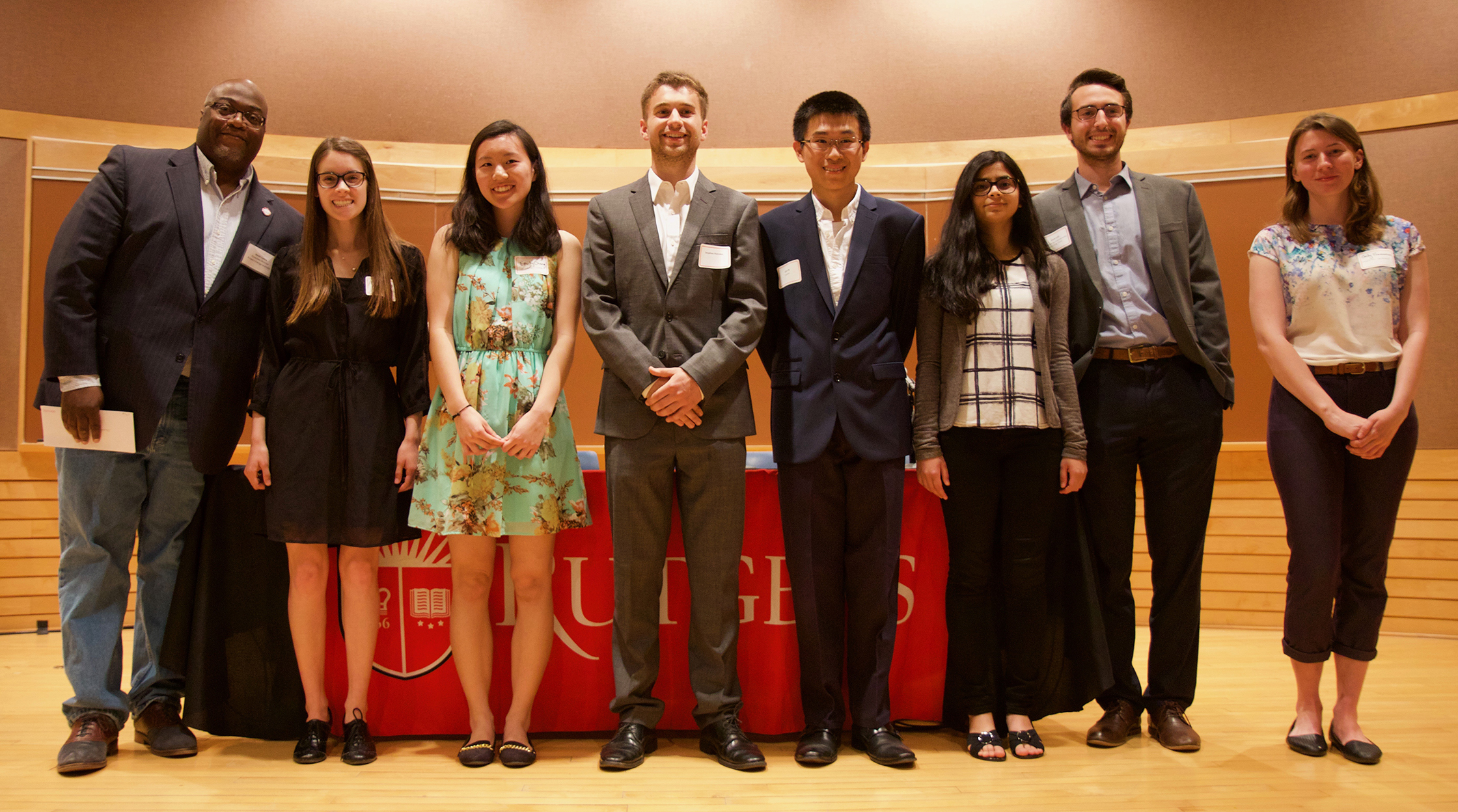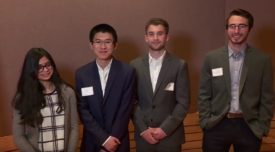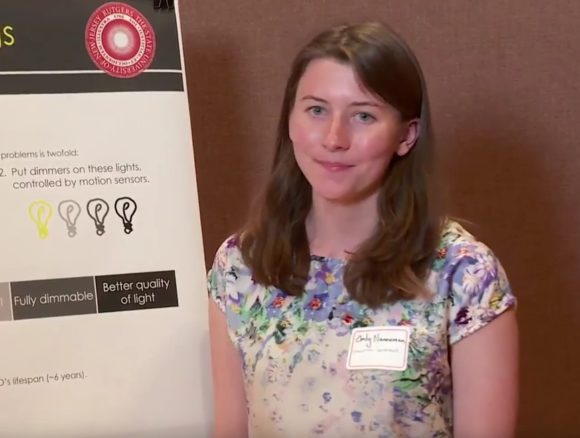
L-R: REI Associate Director Kevin Lyons and 2018 contest winners Maya Robles, Emily Cheng, Stephen Petrides, Zijun Xu, Swati Modhwadia, Evan Lutz and Emily Nanneman.
Each year, the Rutgers Energy Institute (REI) challenges Rutgers undergraduates to develop innovative and implementable plans for reducing energy consumption on the New Brunswick campus through its Energy Innovation Contest, now in its eleventh year. Winners of the 2018 contest were announced during the spring semester at the Rei Annual Symposium by its associate director Kevin Lyons, an associate professor of supply chain management with the Rutgers Business School.

Maya Robles and Emily Cheng making their award-winning presentation.
First place winners, who shared a $2,500 prize, were Emily Cheng (Environmental Policy, Institutions and Behavior major, minor in Economics) and Maya Robles (Environmental Policy, Institutions and Behavior major, minor in Spanish and Cultural Anthropology) for their proposal, “The Collegiate Carbon Exchange.”
Winning the second prize of $1,500 was the team, Students for Environmental & Energy Development-SEED, which comprised Evan Lutz, Emily Sukenik, Zijun Xu, Stephen Petrides and Swati Modhwadia, for its proposal, “Savings Found from Reforming Laundry Room Habits and Installing New Clothes Dryers at Rutgers_New Brunswick.”
The $1,000 third-place prize was claimed by Kyra Frank (Environmental Policy, Institutions and Behavior major, minor in Philosophy) and Emily Nanneman (Environmental Policy, Institutions and Behavior) for the proposal, “Lighting the Way to Savings with LEDs.”

Members of the 2nd place team included, l-r, Swati Modhwadia, Zijun Xu, Stephen Petrides and Evan Lutz. Missing from the photo is Emily Sukenik.
The contest, which represents REI’s commitment to education and outreach, has provided students the unique opportunity to engage with their university environment and the experts around them as they research and conduct technical, economic and policy analyses to provide viable solutions to energy consumption and carbon reduction in their local environment.
According to REI associate director Rachael Shwom, an associate professor in the Department of Human Ecology, the competition has also produced high-quality submissions. “We are very proud of the quality of the proposals our students put forth. Many are creative while being analytically rigorous.”
“When you talk to the winners you can tell they’ve really learned a lot about the social, technical and economic complexities of reducing energy use and greenhouse gas emissions in their own university,” added Shwom.
Several of the student proposals to come out of the annual Energy Innovation Contest have been implemented by the university, most notably tray-less dining and use of aerobic digesters. In addition, students have also gained internships with corporations that produce the researched technology from their REI contest proposals.

Emily Nanneman and missing team mate Kyra Frank won the third prize.
“The Energy Innovation Contest at Rutgers is a unique opportunity for students to change the future of our energy,” said top prize winner Maya Robles. “Too often people become locked-in to one way of looking at energy and work within those confines. This contest gives students a chance to contemplate what’s not working in our system and come up with their own solutions,” she added.
This year’s winning submission from Robles and Emily Cheng, focused on a cap-and-trade program among the Big 10 universities that will accelerate the process to achieve carbon neutrality. Their program, called the College Carbon Exchange (CCX), will provide the mechanism for universities to invest in clean energy and energy efficient operations and engage students to improve their energy behavior.
Swati Modhwadia, whose team placed second in the contest, underscored the value of the competition and its capacity to make a difference. “Realizing the issue is a good first step, but real change lies in what we do. This competition allows students to realize that change is within their power. Despite the daunting environmental issues, some planning, teamwork and a simple idea can go a long way.”
Her fellow team member Evan Lutuz added that “the energy innovation competition is an excellent platform for students to practice creativity and practicality towards sustainability goals. It is very easy to sit back and criticize the energy infrastructure in place in our country and at an institution like Rutgers, but until a report is written and the complexities of costs and implementations are revealed and solved, those criticisms mean nothing. I am so thankful that as a student I can learn so much about myself and get a glimpse into what real-world, energy problem-solving is like.”

